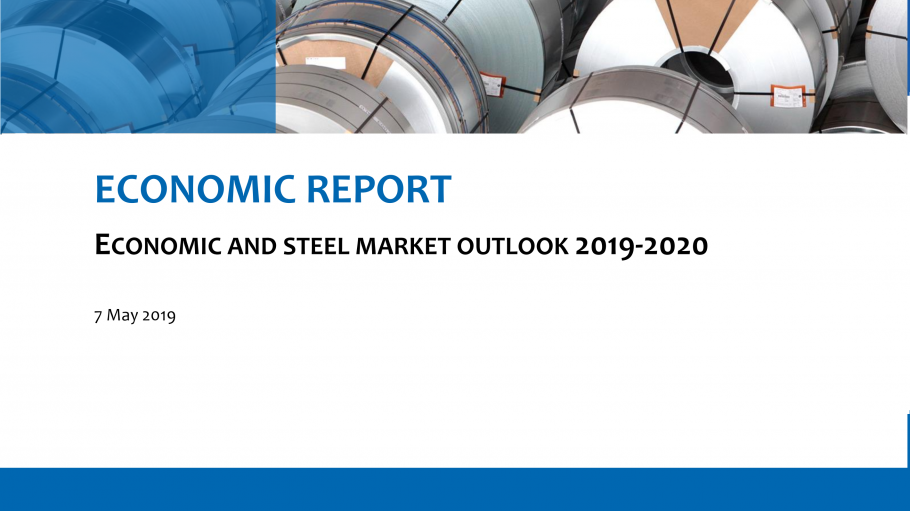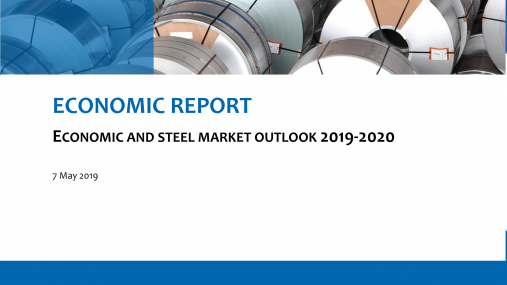
Press releases » Economic and steel market outlook 2019-2020 European steel squeezed between rising import pressure and a depressed home market
Economic and steel market outlook 2019-2020 European steel squeezed between rising import pressure and a depressed home market
Downloads and links
Recent updates

Brussels, 7 May 2019 – Final figures for 2018 show that the EU28 steel market grew – however, forecasts estimate that it will fall slightly in 2019. The preliminary safeguard measures in place since mid-2018 could not prevent third country imports from rising sharply over the year and, as a consequence, local steel producers are finding themselves squeezed by deflected and cut-price steel products from outside the EU.
“The impact of imports having surged over 2018 has squarely hit home. In an EU market that grew by 3.3% last year, imports grew by 12.6% and domestic deliveries by only 1.7%”, said Axel Eggert, Director General of the European Steel Association (EUROFER). “This represents yet further loss of market share for domestic producers”.
The ‘relaxation’ of the final steel safeguard measures – with an enlargement of 5% in February this year with another upwards revision of 5% scheduled for July 2019 and another in July 2020 – operates out of step with the anticipated decline of the EU steel market in 2019. As such, the 15% increase in import quota allowed in the final safeguard measures risks squeezing the EU steel sector, as it will be exposed to rising import pressure in a shrinking market.
“As apparent steel consumption is expected to fall by 0.4% in 2019, the situation for domestic producers will worsen”, emphasised Mr Eggert.
EU steel market overview
In the final quarter of 2018 domestic deliveries from EU mills to the EU market decreased by 2.1% compared with the same period of 2017. This was the result of third country imports growing by 16.3% year-on-year within a context of flattening steel demand growth over that timeframe. Imports amounted to 9.6 million tonnes and accounted for 24.7% of EU steel demand.
Over the whole year 2018 apparent steel consumption rose by 3.3%. Third country imports grew by 12.6% which contrasts sharply with a 1.7% rise in domestic deliveries. The preliminary safeguard measures imposed by the EU Commission in July 2018 were supportive to limiting import volumes in the second half of the year compared with the extraordinary high import volumes that landed in the EU in the first half. However, the sharp year-on-year rise in the second half of the year also illustrates that the threat of deflection of tonnage due to the Section 232 tariffs on steel imports imposed by the US and market distortions due to the global overcapacity and other countries’ protectionist measures is still very much alive.
The outlook for EU steel demand is subdued. The base case scenario for the development of final steel use shows only marginal growth in 2019 and 2020. Given the uncertainty that currently surrounds the EU steel market in terms of demand and supply fundamentals, steel inventories will be managed with care. With reportedly relatively high inventories in the steel distribution chain at the start of 2019, apparent steel consumption is forecast to fall by 0.4% over the whole year 2019. Apparent steel consumption may grow by 1.3% in 2020.
With only a few months of customs data available it is impossible to already see a clear pattern in trade flows. Nevertheless, with imports remaining at elevated levels and exports on a downward trend in early 2019, the justified conclusion seems to be that there is no evidence of an easing in competitive pressures in international steel markets. With global steel overcapacity still estimated to be 550 million tonnes by the OECD, it is of the utmost importance that individual countries and regions dismantle market-distorting subsidies and other government support measures. Additionally, they must share data and information on the process of capacity reduction in order to facilitate the process of cutting excess capacity where it is needed most and avoid a further proliferation of trade distortions.
EU steel-using sectors
Total production growth in EU steel-using sectors cooled further in the fourth quarter of 2018. The strongest slowdown was registered in the automotive sector, followed by the mechanical engineering sector, the steel tube industry and the metal goods industry. Meanwhile, production activity in the construction sector did not witness much of a growth deceleration, but continued to expand at a healthy pace.
Prospects for production activity in EU steel-using sectors in 2019 and 2020 are rather weak, with external and internal headwinds undermining the outlook. While private consumption and government expenditure will continue to grow, both exports and investment are at risk of falling behind expectations in case of a hard Brexit and an escalation in global protectionist measures. The significant degree of uncertainty the corporate sector is facing has clearly the potential to lead to a negative confidence shock and investment decisions being postponed until more clarity emerges on trade conditions and Brexit. On the other hand, a well-managed Brexit and settlement of US-EU trade disputes would pose an upside risk.
Output in the EU’s steel-using sectors is forecast to grow by 0.9% in 2019 and by 1.1% in 2020.
EU economic context
Slowing global economic momentum and the related deteriorating contribution from net trade has been the primary reason for the weakening of the EU economy in 2018. The slowdown was led by the industrial sector, bearing the brunt of global headwinds. Export orders gradually weakened, dragging on confidence.
Available forward-looking indicators and hard data seem to justify the conclusion that the weakness in industry will at least persist over the first half of 2019. The base-case scenario for economic growth in the EU suggests that – nevertheless fairly solid – domestic economic fundamentals could offset the weakness in trade. However, investment is particularly at risk of falling behind expectations if rising protectionism and a worsening global economic environment lead to a further deterioration in business confidence.
EUROFER’s second quarter 2019 forecast for EU GDP growth is 1.5% in both 2019 and 2020.
Contact
Charles de Lusignan, Spokesperson and head of communications, +32 2 738 79 35, (charles@eurofer.be)
About the European Steel Association (EUROFER)
EUROFER AISBL is located in Brussels and was founded in 1976. It represents the entirety of steel production in the European Union. EUROFER members are steel companies and national steel federations throughout the EU. The major steel companies and national steel federations in Switzerland and Turkey are associate members.
About the European steel industry
The European steel industry is a world leader in innovation and environmental sustainability. It has a turnover of around €170 billion and directly employs 330,000 highly-skilled people, producing on average 160 million tonnes of steel per year. More than 500 steel production sites across 22 EU Member States provide direct and indirect employment to millions more European citizens. Closely integrated with Europe’s manufacturing and construction industries, steel is the backbone for development, growth and employment in Europe.
Steel is the most versatile industrial material in the world. The thousands of different grades and types of steel developed by the industry make the modern world possible. Steel is 100% recyclable and therefore is a fundamental part of the circular economy. As a basic engineering material, steel is also an essential factor in the development and deployment of innovative, CO2-mitigating technologies, improving resource efficiency and fostering sustainable development in Europe.

Download files or visit links related to this content
Developed with the support of the Offshore Wind Foundation Alliance and European Wind Tower Association, the position paper outlines the strategic importance of wind components for Europe’s green transition and calls for targeted measures to strengthen their role within the NZIA.
Brussels, 2 April 2025 - The latest data unveiled by the OECD in its meeting in Paris draw an extremely worrying picture, where global steel excess capacity is expected to grow from an estimated 602 million tonnes in 2024 to 721 million tonnes by 2027 – over five times the EU's steel production. The European steel industry - already severely hit by the spill-over effects of global overcapacity and the U.S. steel import tariffs - reiterates the crucial need for strict and effective EU post-safeguard measures to ensure its survival.
Brussels, 19 March 2025 – The Steel and Metals Action Plan, unveiled today by the European Commission, provides the right diagnosis to the existential challenges facing the European steel industry. Concrete measures need to follow swiftly to reverse the decline of the sector, re-establish a level playing field with global competitors, and incentivise investment and uptake of green steel in the market.